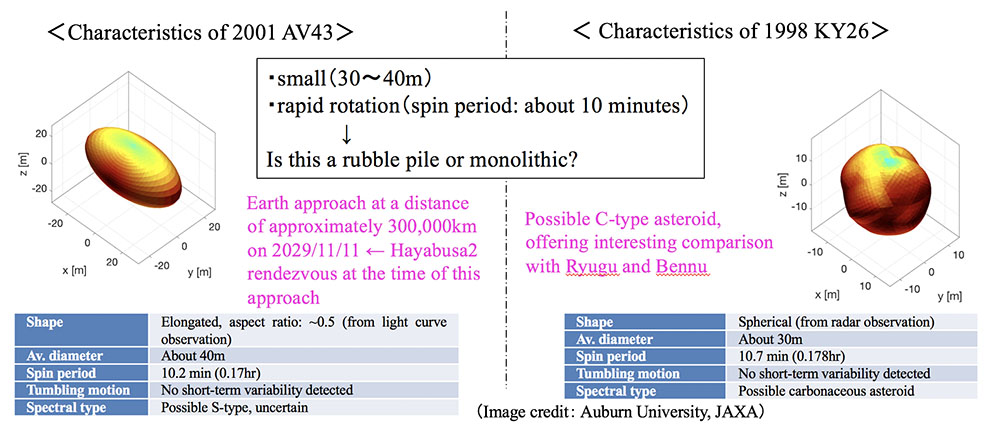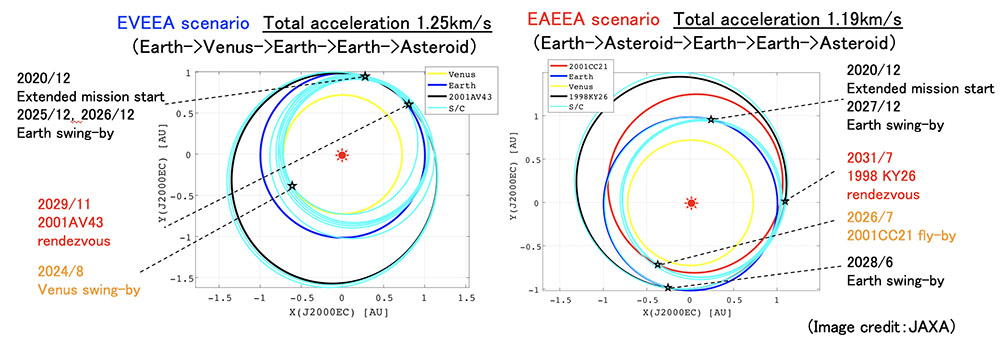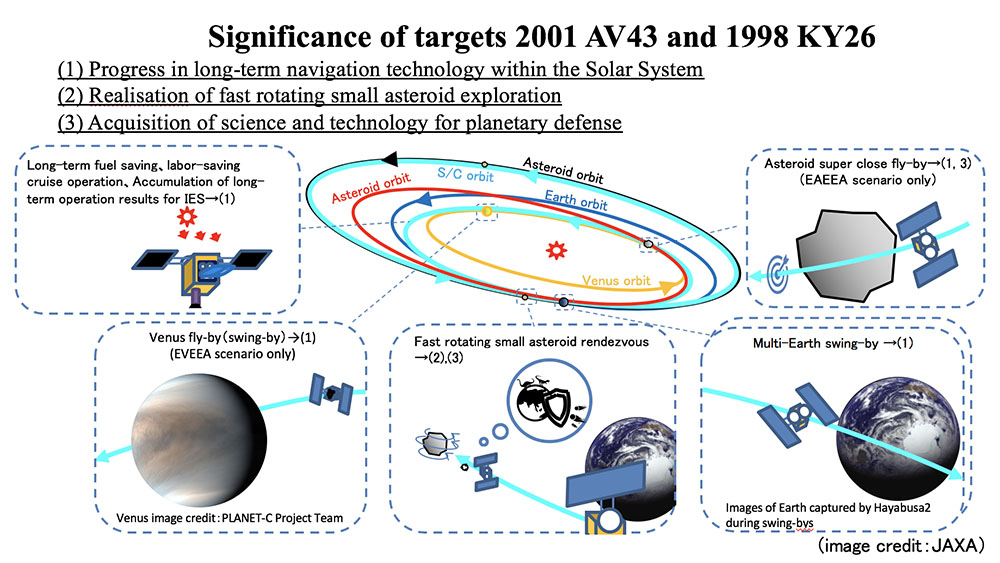After returning to Earth in December 2020, Hayabusa2 will separate the capsule and return to deep space. As about half of the fuel (xenon) for the ion engine is expected to remain at this time, there is the potential to continue on to a new mission. We therefore examined what kind of mission would be possible.
Initially, a search was performed to identify celestial objects that could be reached using the residual fuel. 354 candidates were found. Then the engineering viewpoint was considered, including details such as the level of orbit control required to reach the celestial object, how well the orbit of target object was determined and the feasibility of the spacecraft operations. The size of the target object, rotation speed and type were also scrutinized to rank the celestial objects by their scientific interest. Finally, the selection was narrowed down to two objects: 2001 AV43 and 1998 KY26 (Figure 1).
Both these candidates are very small celestial bodies with diameters of a few tens of meters. The asteroids are referred to as ‘fast rotators’ because of their extremely rapid rotation period of just 10 minutes. An object with these characteristics has never been visited by humanity before, and the comparative observations with asteroid Ryugu are expected to deepen the scientific knowledge obtained from Ryugu.

Figure 1: Characteristics of the exploration candidate celestial bodies
(image credit: Auburn University, JAXA).
The orbits of these two celestial objects are different, and the plan to reach 2001 AV43 goes via Venus, while the route to 1998 KY26 is via another asteroid. We call these scenarios EVEEA (Earth → Venus → Earth → Earth → Asteroid) and EAEEA (Earth → Asteroid → Earth → Earth → Asteroid). The main difference is the Venus swing-by in 2024 for the EVEEA scenario and the asteroid fly-by in 2026 for EAEEA (Figure 2). The arrival at 2001 AV43 is scheduled for November 2029, and the arrival at 1998 KY26 is scheduled for July 2031. They will be long-term missions that will take about 10 years.

Figure 2: Trajectory diagrams for each scenario (image credit: JAXA).
Although these two scenarios have different characteristics, the possible extended missions share the following three attributes (Figure 3):
- Advance long-term navigation technology within the Solar System.
Based on the engineering achievements of the Earth-return mission, the extended mission will advance the development of operation technology necessary for more flexible and distant exploration, and for scientific observations during long-term navigation and fly-bys. - Realization of fast rotating asteroid exploration.
The extended mission will investigate rapidly rotating small asteroids –an unexplored area—and further deepen the scientific knowledge obtained from Ryugu. In addition, the mission will aim to acquire new asteroid exploration technology by the approach within this special environment, where the rotation speed is sufficiently fast that the centrifugal force dominates gravity on the asteroid surface. -
Acquisition of science and technology that contributes to Planetary Defense.
Asteroids 10s m in size can cause regional damage if they collide with the Earth. Through exploration of this asteroid type and elucidation of their origin, technology and knowledge can be acquired that contributes to activities to prevent disasters caused by celestial objects colliding with the Earth (Planetary Defense).

Figure 3: Schematic diagram of the exploration significance (image credit: JAXA).
As mentioned above, it will take a further 10 years after returning to the Earth to reach the target celestial body. Hayabusa2 was designed for the Earth-return mission, and the life of the onboard equipment is not guaranteed over this extended period. Therefore, a failure or malfunction could occur at any time. Under these circumstances, Hayabusa2 plans to accumulate mission results during the flight while carrying out the extended mission.
We plan to focus on one of the two candidate missions this fall. This mission and the budget must be approved in order to actually proceed with the extended mission. After safely delivering the capsule to Earth, we look forward to moving onwards to new challenges!
Reference:
Press briefing material from July 22, 2020.
Hayabusa2 Project
2020.08.03

